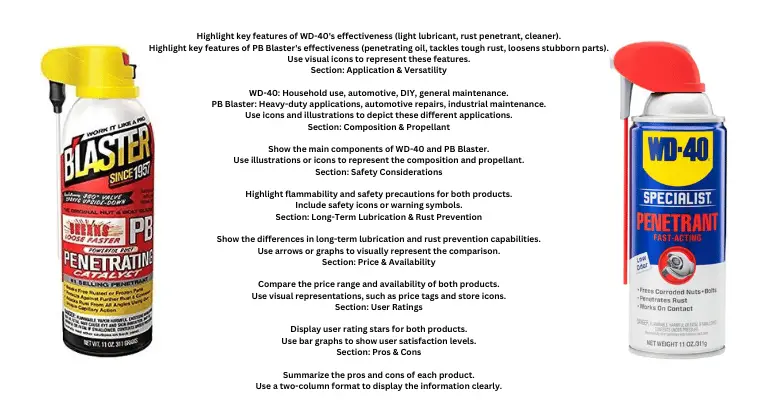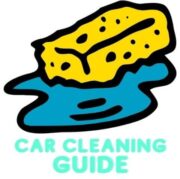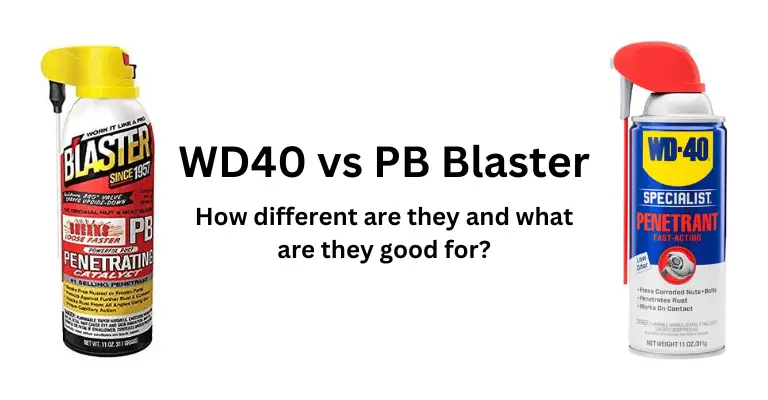Last Updated on September 29, 2023 by Chase Manhattan
In the realm of lubricants and rust removers, two names often reign supreme: WD40 and PB Blaster.
Both have achieved hero status in the world of maintenance, each with their own legion of loyal fan base. But, are they really the same? Or do they each offer a unique blend of performance and efficiency?
Welcome to the ultimate showdown between WD40 and PB Blaster, where we peel back the layers of brand reputation and delve into the nitty-gritty of their capabilities.
This comparison aims to dissect their strengths, weaknesses, and ideal usage scenarios, giving you the insights you need to make an informed decision. So, strap in and prepare for a detailed exploration of these two industry titans. It’s time to find out if it’s a case of ‘same same, but different’ or if one truly outshines the other.
- How to Clean Car Carpets Quick and Easy - July 10, 2024
- Can You Touch Up Clear Coat? Yes and No (Here’s Why) - November 25, 2023
- How To Wax A Car By Hand: A Comprehensive Guide - November 14, 2023

Quick Navigation
Introducing WD-40
WD-40 is a name that resonates with many. It’s an iconic product, having been around since the early 1950s. The “WD” in WD-40 stands for Water Displacement, hinting at one of its primary functions. This petroleum-based lubricant is a blend of secret ingredients, which includes anti-corrosion agents and various lubricants.
WD40 Pros and Cons Table
| Pros | Cons |
|---|---|
| Versatile: Suitable for various tasks, including lubrication, rust prevention, and light cleaning. | Temporary Lubrication: May require frequent reapplication for long-lasting lubrication. |
| Affordable: Budget-friendly and widely available in stores and online retailers. | Limited Rust Prevention: Provides basic rust protection but not ideal for long-term corrosion prevention. |
| Widely Used: Popular and trusted by many users for its effectiveness in household applications. | Flammable: It is flammable and should be used with caution around open flames or sparks. |
| Pleasant Smell: Some users find the characteristic smell of WD-40 pleasant. | Not Heavy-Duty: Not suitable for tackling tough rust or heavily stuck parts. |
| Multi-Purpose: Can be used for various DIY projects, automotive maintenance, and general tasks. | May not be ideal for professional or heavy-duty industrial use. |
WD-40 Uses and Benefits
WD-40 is touted for its multi-purpose functionality. This versatility has cemented its status as a must-have in every household, garage, or workshop. Here are some ways drivers and maintenance professionals utilize WD-40:
- Rust removal and cleaning
- Lubrication of door handles and seat belt mechanisms
- Bird droppings removal
- Moisture displacement from components
- Carbon deposits removal
- Engine grime and grease removal
- Quieting squeaky brakes
- Unfreezing rusted parts
- Scuffs and marks removal from bodywork
WD-40’s water-displacement formula is gentle yet robust, cutting through grime without causing damage. It’s no wonder this trusty can is found in countless homes and garages worldwide.
WD-40 Drawbacks
Despite its wide-ranging uses, WD-40 has a few shortcomings. For instance, it struggles with freeing severely rusted bolts. Furthermore, when sprayed onto polystyrene or polycarbonate, fumes may be created.
Introducing PB Blaster
A formidable competitor to WD-40 is PB Blaster. Introduced in 1957, this penetrating oil has carved out a niche for itself, particularly in the industrial, marine, and plumbing sectors. PB Blaster’s water-based formula comprises anti-corrosion chemicals and a non-evaporating lubricant.
PB Blaster Pros and Cons Table
| Pros | Cons |
|---|---|
| Exceptional Penetration: Highly effective at breaking free rusted and stuck parts. | Strong Odor: PB Blaster has a distinct, strong odor that can be overpowering in enclosed spaces. |
| Heavy-Duty: Designed for challenging rust removal and industrial applications. | Highly Flammable: Use with extreme caution in the presence of flames, sparks, or heat sources. |
| Longer-Lasting Lubrication: Offers better and more durable lubrication compared to WD-40. | More Expensive: Generally slightly costlier due to its heavy-duty capabilities. |
| Professional-Grade: Ideal for automotive repairs, industrial maintenance, and heavy tasks. | Not Versatile: Primarily suited for heavy-duty tasks and may not be as effective for light household use. |
| Positive User Ratings: Highly regarded for its effectiveness and performance. | Limited Rust Prevention: Not designed for long-term rust prevention solutions. |
PB Blaster Uses and Benefits
PB Blaster is lauded for its ability to combat severe cases of rust and corrosion. It can also clean, lubricate, and protect metal objects from future rusting. Here are some of the ways in which PB Blaster is commonly used:
- Rust prevention and removal
- Metal object protection against moisture
- Maintenance of metal object shine and luster
- Removal of stubborn dirt and corrosion
The effectiveness of PB Blaster in accessing small gaps and nooks makes it a go-to product for many users. Its post-application work also sets it apart, as it continues protecting components from water and future rusting.
PB Blaster Drawbacks
Despite its effectiveness, the use of PB Blaster comes with a few caveats. The application process produces a lot of fumes, which could be a challenge for some users. Therefore, wearing protective gear during application is advisable.
WD40 vs PB Blaster: A Head-to-Head Comparison
The choice between WD40 and PB Blaster often boils down to the specific needs of the user. To help you make an informed decision, let’s delve into an in-depth comparison of these products – but first, check out this table for a high-level overview:
| Feature | WD-40 | PB Blaster |
|---|---|---|
| Overview | WD-40 is a versatile household lubricant and cleaner | PB Blaster is a penetrating oil and lubricant spray |
| Effectiveness | Effective as a light lubricant, rust penetrant, and cleaner. Suitable for small tasks and light corrosion. | Exceptional as a penetrating oil, able to break free rusted and stuck parts. Ideal for heavy-duty and challenging rust removal. |
| Application | Lubrication, rust prevention, moisture displacement, and light cleaning. | Penetrates rust, loosens stuck bolts, nuts, and other stubborn parts. |
| Versatility | Versatile for household use, automotive, DIY projects, and general maintenance. | Primarily designed for heavy-duty applications, automotive repairs, industrial maintenance, and professional use. |
| Composition | Contains a mix of solvents, mineral oil, and corrosion inhibitors. | Formulated with a blend of solvents, oils, and proprietary additives. |
| Propellant | Propellant used is CO2. | Propellant used is propane and butane. |
| Odor | WD-40 has a characteristic smell that some may find pleasant. | PB Blaster has a distinct, strong odor that can be overpowering in enclosed spaces. |
| Flammability | WD-40 is flammable and should be used with caution near open flames or sparks. | PB Blaster is highly flammable and should be used with extreme caution in the presence of flames, sparks, or heat sources. |
| Long-Term Lubrication | WD-40 provides temporary lubrication but may require frequent reapplication. | PB Blaster offers longer-lasting lubrication, reducing the need for frequent reapplication. |
| Rust Prevention | Provides basic rust protection but may not be suitable for long-term corrosion prevention. | Not designed as a long-term rust prevention solution. |
| Price | Generally more affordable and budget-friendly. | Often slightly more expensive due to its heavy-duty capabilities. |
| User Ratings | Popular and widely used, with generally positive user reviews. | Highly regarded for its effectiveness, especially in tackling tough rust and corrosion. Users praise its performance. |
| Availability | Easily available in hardware stores, supermarkets, and online retailers. | Widely available in automotive supply stores, online, and some hardware stores. |
Versatility
In terms of versatility, WD40 reigns supreme. Its water-displacement spray is suitable for hundreds of tasks, from rust removal to grime cutting. PB Blaster, however, is primarily designed for heavy-duty rust and corrosion removal.
Efficiency at Removing Rust
PB Blaster takes the crown when it comes to rust removal. Its high-quality oil-based formula allows it to cover all the small gaps, nooks, and crannies, removing rust and dirt simultaneously. While WD40 also features anti-corrosion properties, PB Blaster is generally considered the stronger product in this department.
Raw Power
When it comes to power, PB Blaster edges out WD40. Its high-quality corrosion removal properties allow it to remove grime, dirt, and other unwanted particles with greater precision and accuracy. Although WD40 is a formidable agent, PB Blaster delivers more with less effort.
Performance
PB Blaster is a high-performing penetrating oil. It easily slips into various nooks and crannies, cleaning them spotless. Its accessibility makes it highly efficient in its tasks. While WD40 is also a reliable product, its performance pales in comparison to that of PB Blaster.
Safety Facts
In terms of safety, WD40 is the safer option. Its water-based formula doesn’t contain as many potentially harmful chemicals as PB Blaster. However, it’s important to read the instructions on the can thoroughly and keep them out of the reach and sight of children.
Price
Price-wise, WD40 is a cheaper option. However, PB Blaster’s higher price tag is justified by its superior rust removal power.
Reference Video
If you still have questions, I recommend checking out this video before we come to our verdict:
The Verdict: WD40 vs PB Blaster
In the battle of WD40 vs PB Blaster, the winner largely depends on your specific needs. If you’re looking for a versatile product that can handle a wide array of tasks, WD40 is your go-to. However, for heavy-duty rust and corrosion removal, PB Blaster is the superior choice.
Despite their differences, both products are effective at cleaning stubborn dirt, removing rust, and preventing future rusting. Whether you choose WD40 or PB Blaster, you’re sure to be pleased with the results.
FAQs and Related Questions
Which product is more effective for rust removal?
PB Blaster is more effective for rust removal due to its exceptional penetrating properties. It can break free rusted and stuck parts with ease, making it the preferred choice for heavy-duty applications.
Is WD-40 safe to use around open flames or sparks?
WD-40 is flammable, and caution should be exercised when using it around open flames or sparks. It’s advisable to keep it away from potential ignition sources and follow the safety instructions on the product label.
Can I use PB Blaster for household tasks and general maintenance?
While PB Blaster is highly effective for heavy-duty applications, it may not be the best choice for general household tasks due to its strong odor and higher price. For lighter tasks, WD-40’s versatility and affordability are more suitable.
Does WD-40 provide long-lasting lubrication?
WD-40 provides temporary lubrication, making it ideal for short-term tasks and applications. For longer-lasting lubrication, consider using PB Blaster, especially for parts that require extended protection and reduced reapplication.
Are there any specific safety considerations when using PB Blaster?
Yes, PB Blaster is highly flammable, and users should exercise extreme caution when using it around flames, sparks, or heat sources. Adequate ventilation in enclosed spaces is essential due to its strong odor. Follow the safety guidelines provided on the product label.
Conclusion
The debate of WD40 vs PB Blaster boils down to specific use cases. Both products offer a plethora of benefits, making them a staple in homes, garages, and workshops. Whether you’re battling rust, loosening stuck parts, or lubricating mechanisms, both WD40 and PB Blaster offer reliable solutions. The choice between the two will ultimately depend on your specific needs and preferences.

